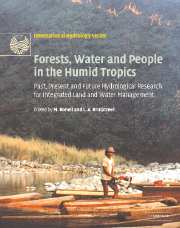 Forests, Water and People in the Humid Tropics
Forests, Water and People in the Humid Tropics Published online by Cambridge University Press: 12 January 2010
INTRODUCTION
Tropical forest loss: extent, patterns and causes
Land use patterns in most humid temperate countries have more or less stabilised over the past century. Changes are still taking place (e.g. urbanisation in some areas, abandonment of agricultural cropping in favour of natural regeneration in others) but they are generally rather gradual. This is not the case in most humid tropical countries where significant land use changes are still under way and often take place at an unprecedented rate. Most of these relate to changes from the original forest cover to either heavily modified (degraded) forest or non-forest land use, such as (slash and burn) agriculture, grazing or plantations of various types.
The spatial extent and trends of land cover change in the tropics have been the subject of much debate, mainly because of the different definitions for various vegetation cover types used by the respective surveys. Although it has proven difficult to obtain accurate and verifiable figures, the successive Forest Resources Assessments (FRA) of the United Nations Food and Agriculture Organization (FAO) have produced an overall picture from which a number of conclusions can be drawn. The estimated average rates of closed tropical forest loss in the developing world are about 14.6 and 14.9 million ha year-1 for the periods 1980–1990 and 1990–2000, respectively. As such, an area of almost 300 million ha of closed tropical forest has disappeared during the last two decades (roughly equivalent to two-thirds of continental Europe excluding Russia).
To save this book to your Kindle, first ensure no-reply@cambridge.org is added to your Approved Personal Document E-mail List under your Personal Document Settings on the Manage Your Content and Devices page of your Amazon account. Then enter the ‘name’ part of your Kindle email address below. Find out more about saving to your Kindle.
Note you can select to save to either the @free.kindle.com or @kindle.com variations. ‘@free.kindle.com’ emails are free but can only be saved to your device when it is connected to wi-fi. ‘@kindle.com’ emails can be delivered even when you are not connected to wi-fi, but note that service fees apply.
Find out more about the Kindle Personal Document Service.
To save content items to your account, please confirm that you agree to abide by our usage policies. If this is the first time you use this feature, you will be asked to authorise Cambridge Core to connect with your account. Find out more about saving content to Dropbox.
To save content items to your account, please confirm that you agree to abide by our usage policies. If this is the first time you use this feature, you will be asked to authorise Cambridge Core to connect with your account. Find out more about saving content to Google Drive.